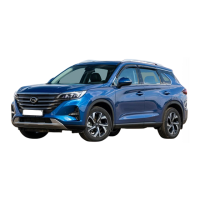5. Driving Directions
5.7.4 High-efficiency Use of Vehicle
– Before driving, make sure the parking brake is
released fully and its indicator light is off.
– Keep sufficient tire pressure. Insufficient tir
e
pr
essure will result in tire wear and fuel waste.
– Make sure wheels are accurately positioned.
Inaccurate positioning makes the tires wear
out faster, increases engine load and wastes
fuel.
– Do not overload the vehicle. Unload
unnecessary articles from the vehicle.
Overload will increase the load of the engine
and waste fuel.
– Accelerate the vehicle slowly and evenly, but
not sharply. For MT models, shift the gear
based on the speed as soon as possible.
– Avoid traffic jams, which will waste fuel, as far
as possible.
– Drive according to traffic signal lights or keep
a safe distance from other vehicles, and avoid
unnecessary park or emergency braking to
save fuel and reduce wear of the brake
system.
– Do not put the food on the brake pedal during
driving to prevent untimely wear and
overheating the brake pad and waste of fuel.
– Select good pavement when driving. When
driving on an uneven road, control the speed
well to avoid collision or scratch.
– Remove mud or other foreign matters stuck
on chassis to reduce vehicle weight and
prevent corrosion.
– Maintain the vehicle regularly to keep it under
best operating conditions. Dirty air filters,
unclean spark plugs, polluted engine oil and
grease will weaken engine performance and
waste fuel.
– Drive slowly for several minutes after starting
at low temperature, and then accelerate after
the engine warms.
– Do not open windows when driving at high
speed.
– Use the AC and other devices properly.
– Shut off the engine for long-time parking and
avoid wasting fuel by long-time running at idle
speed.
245

